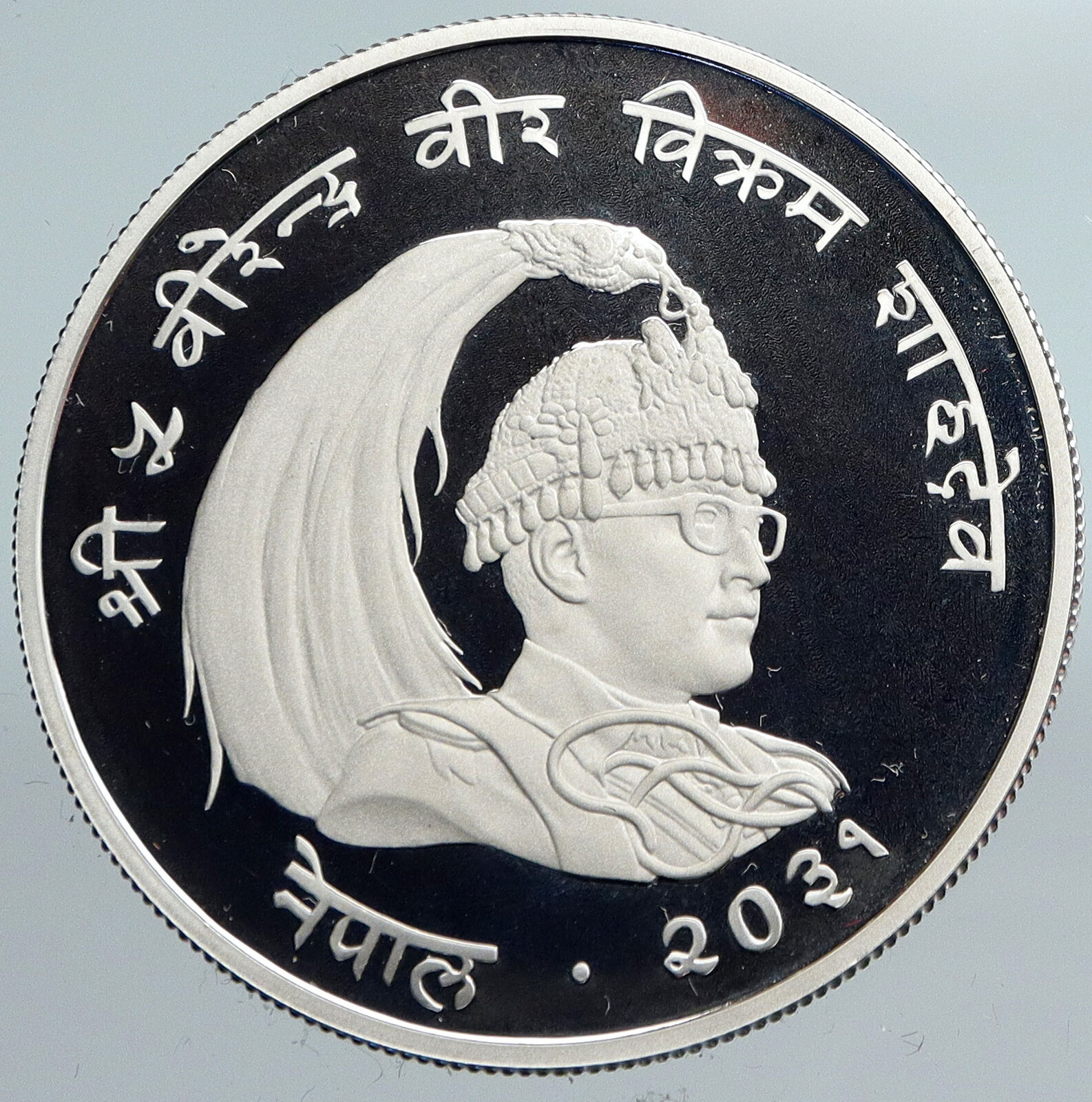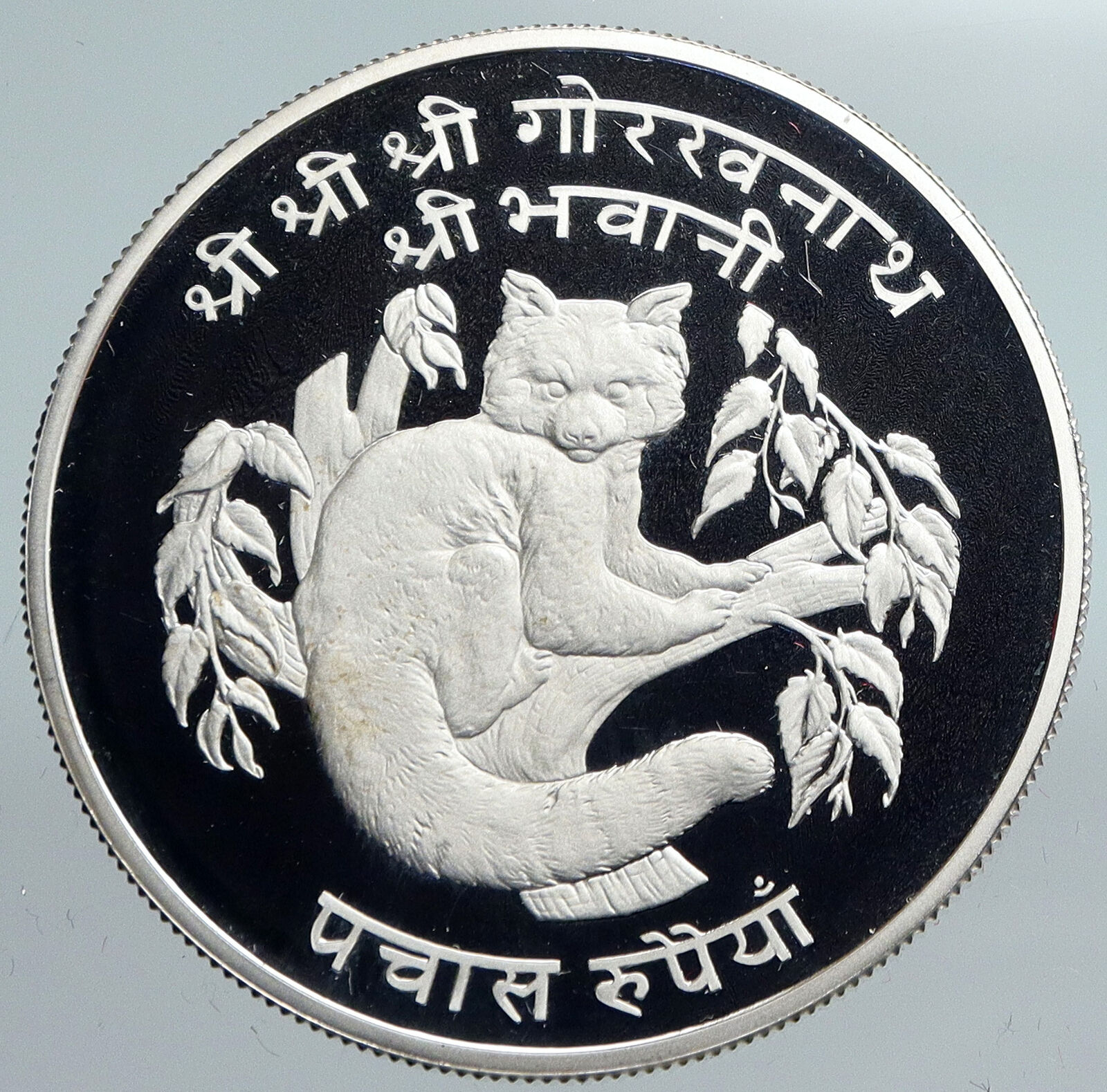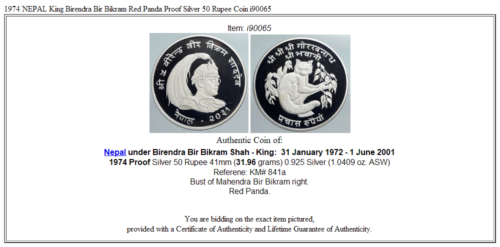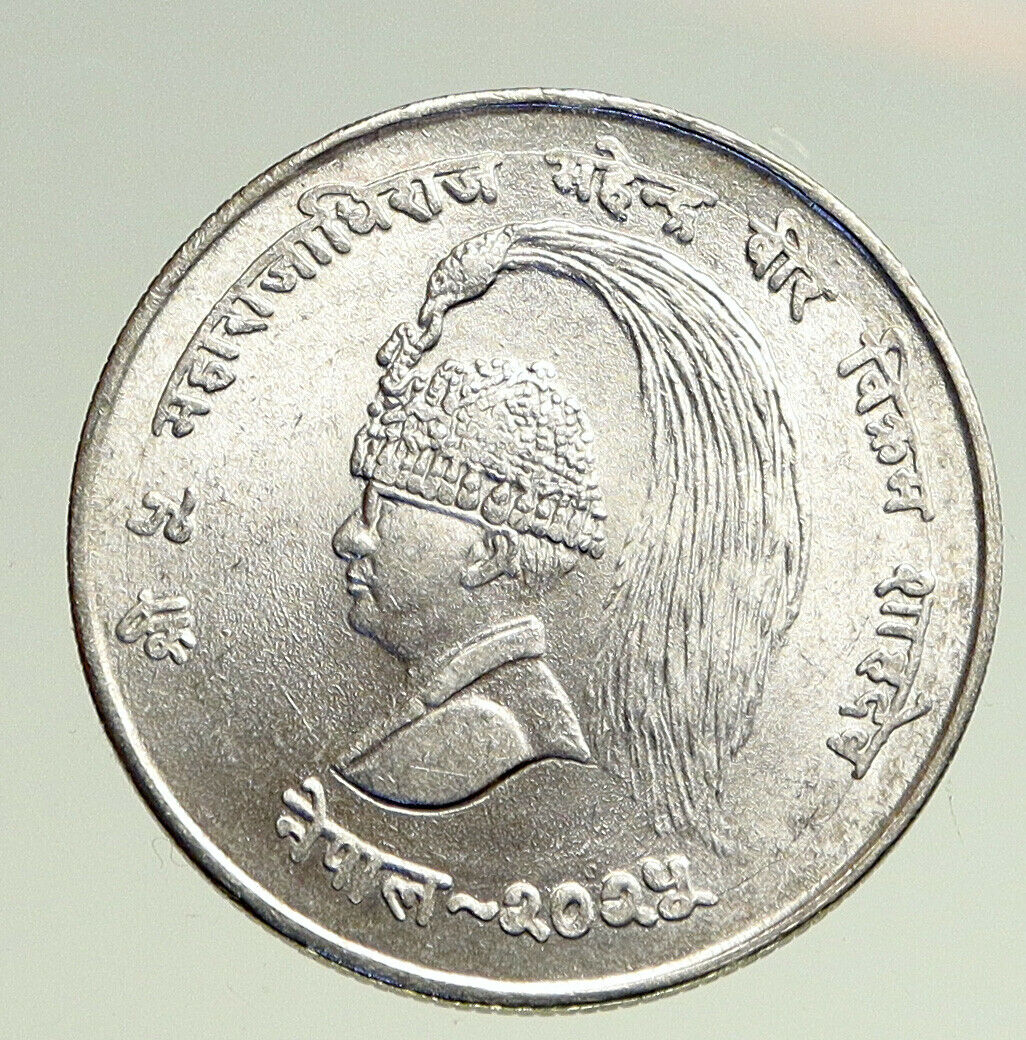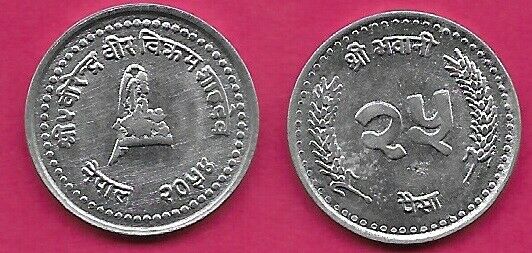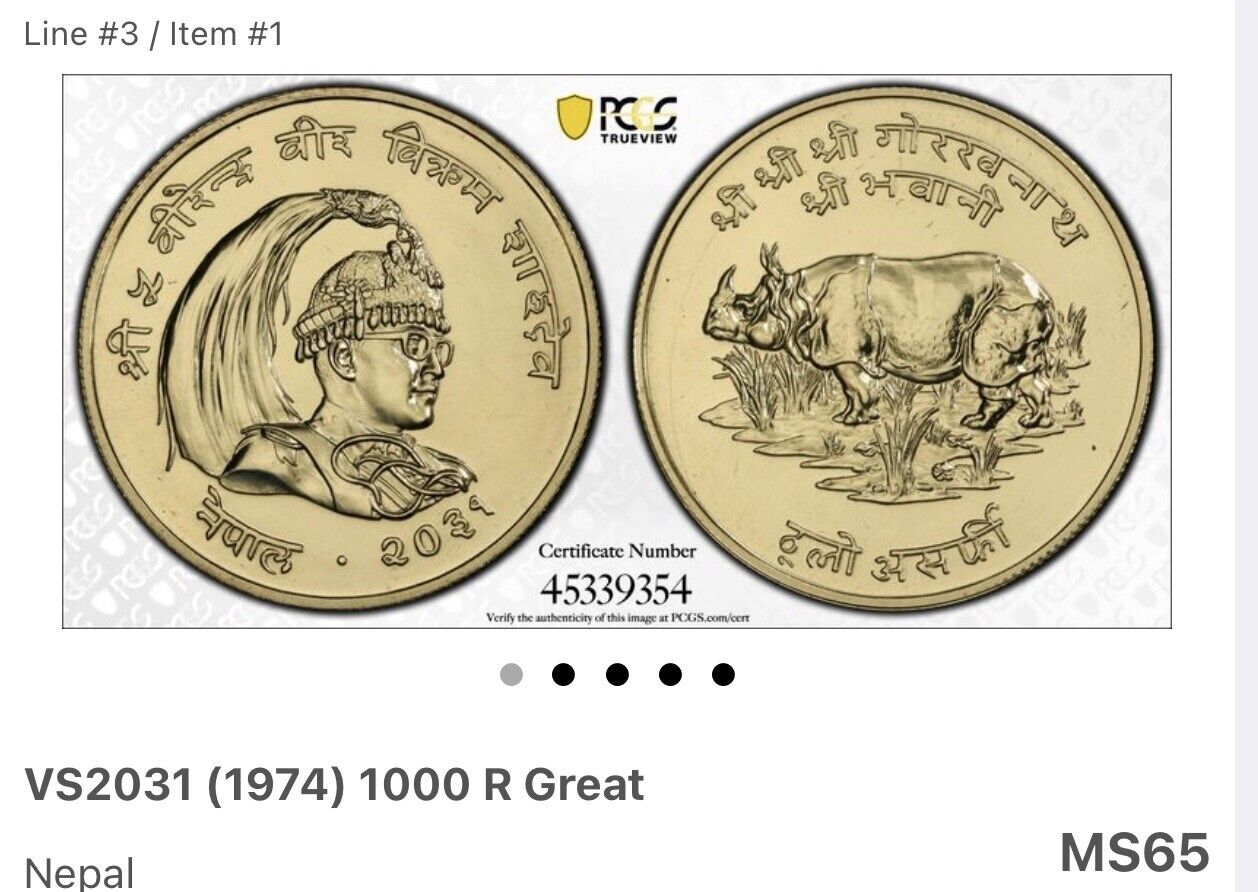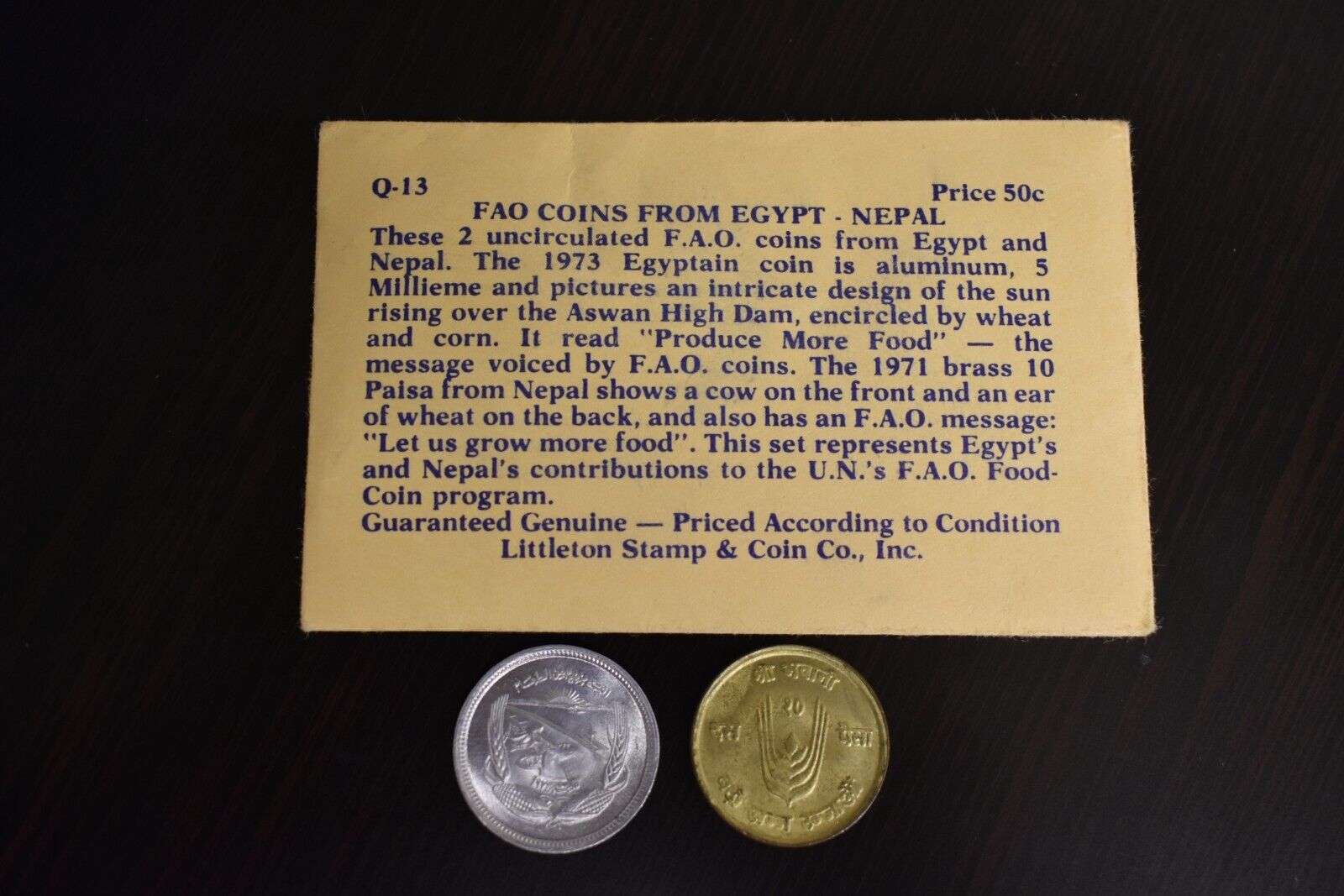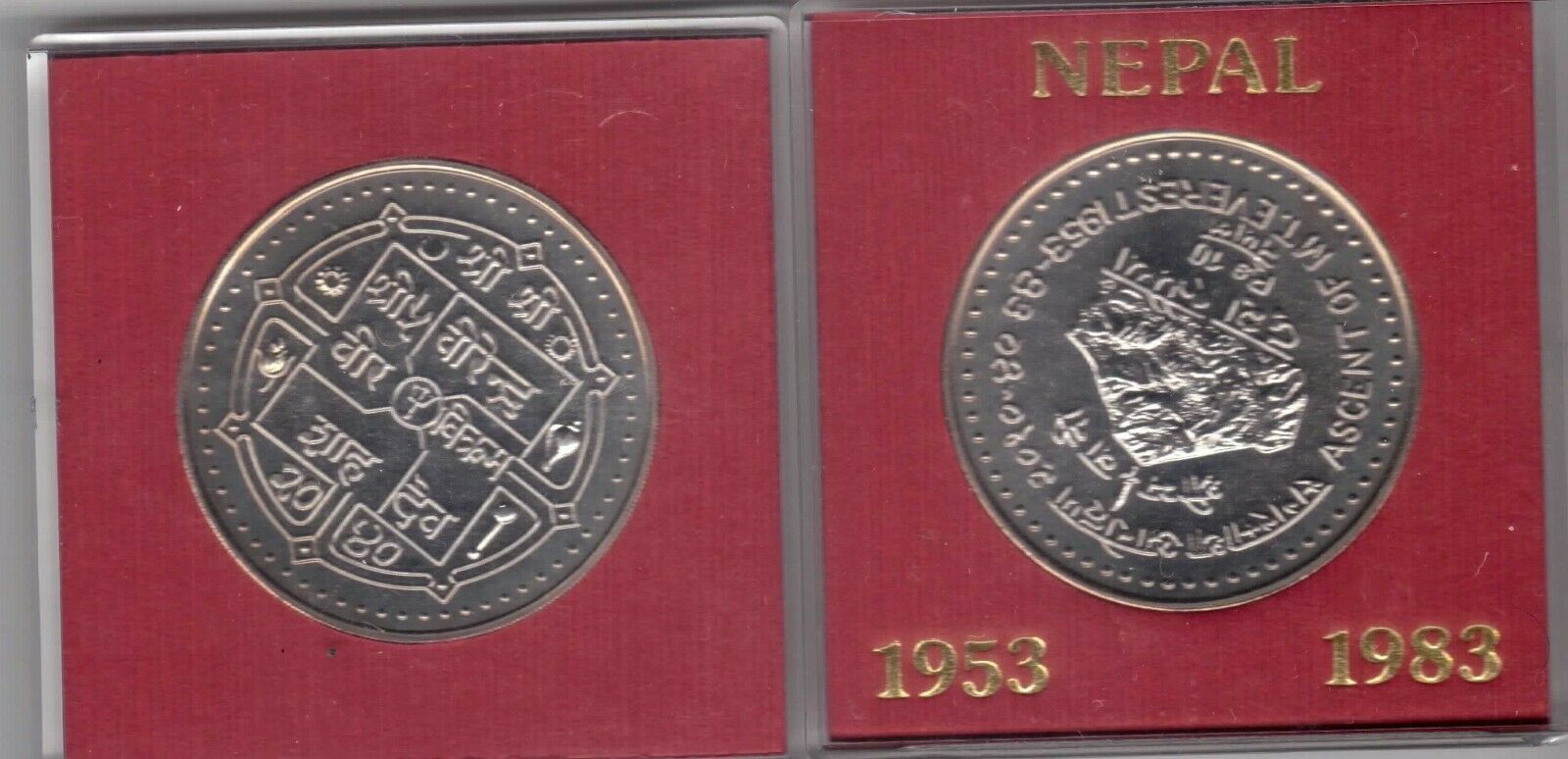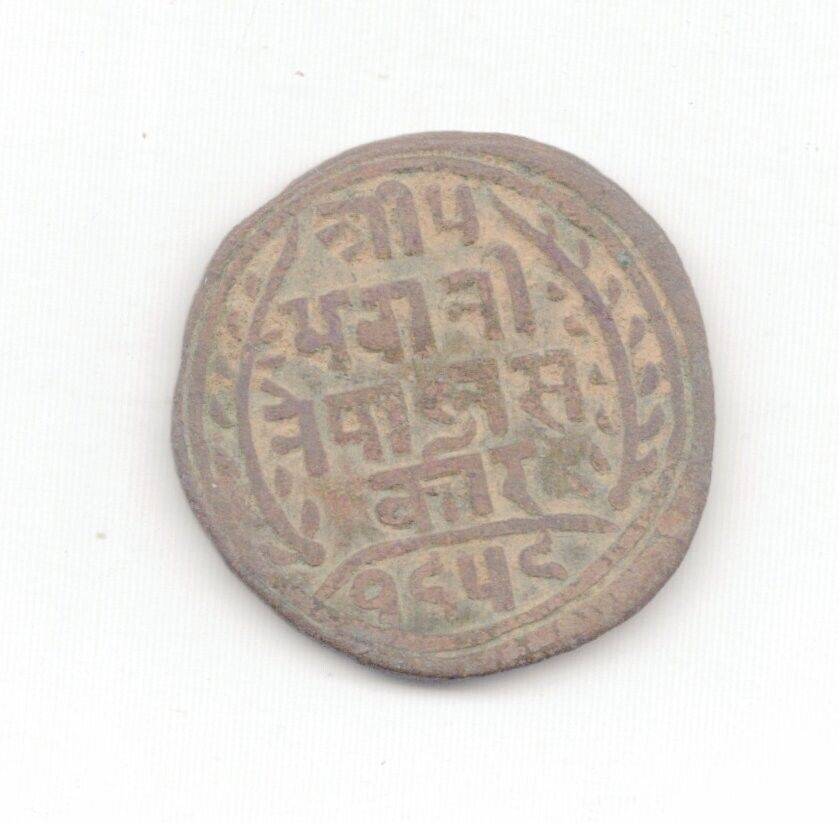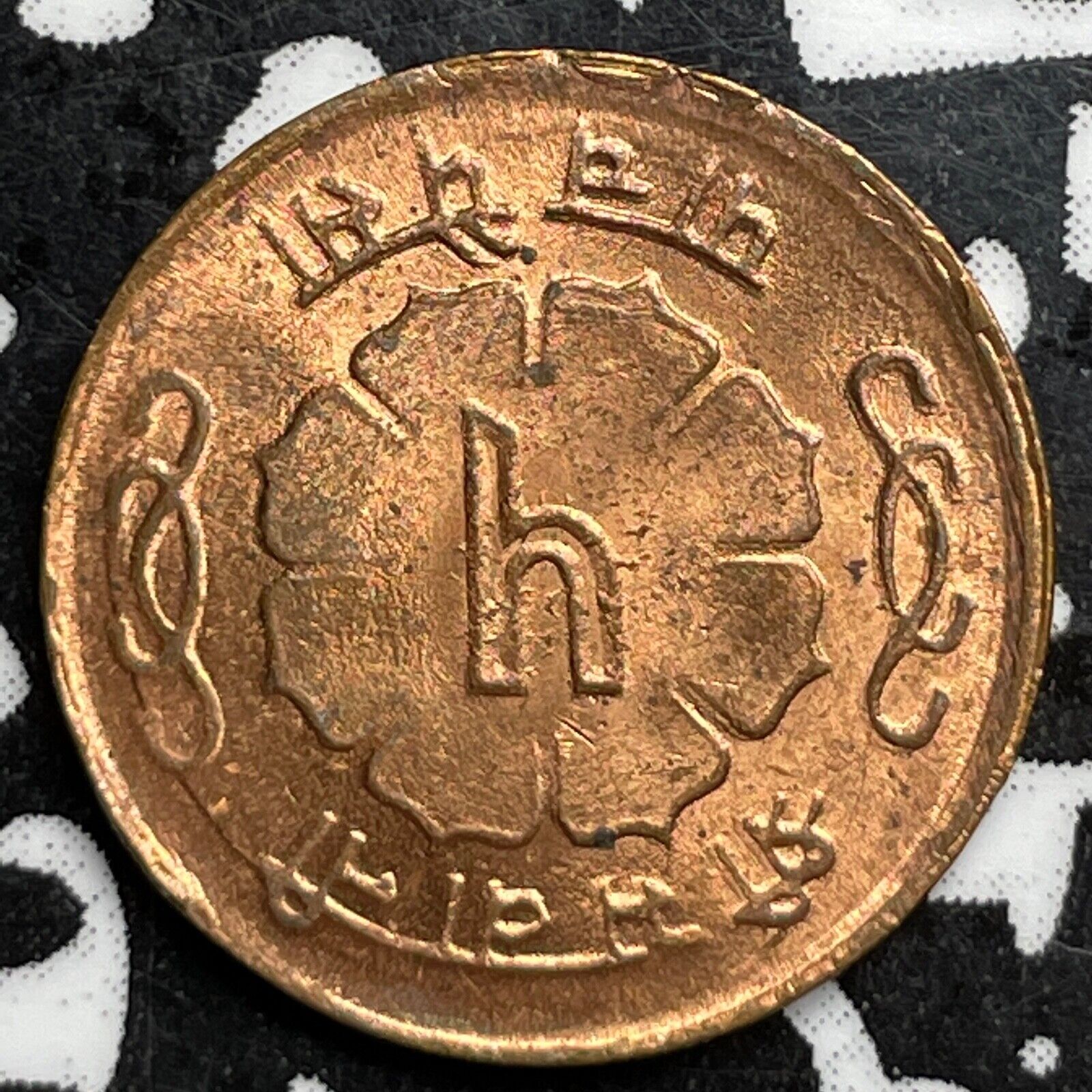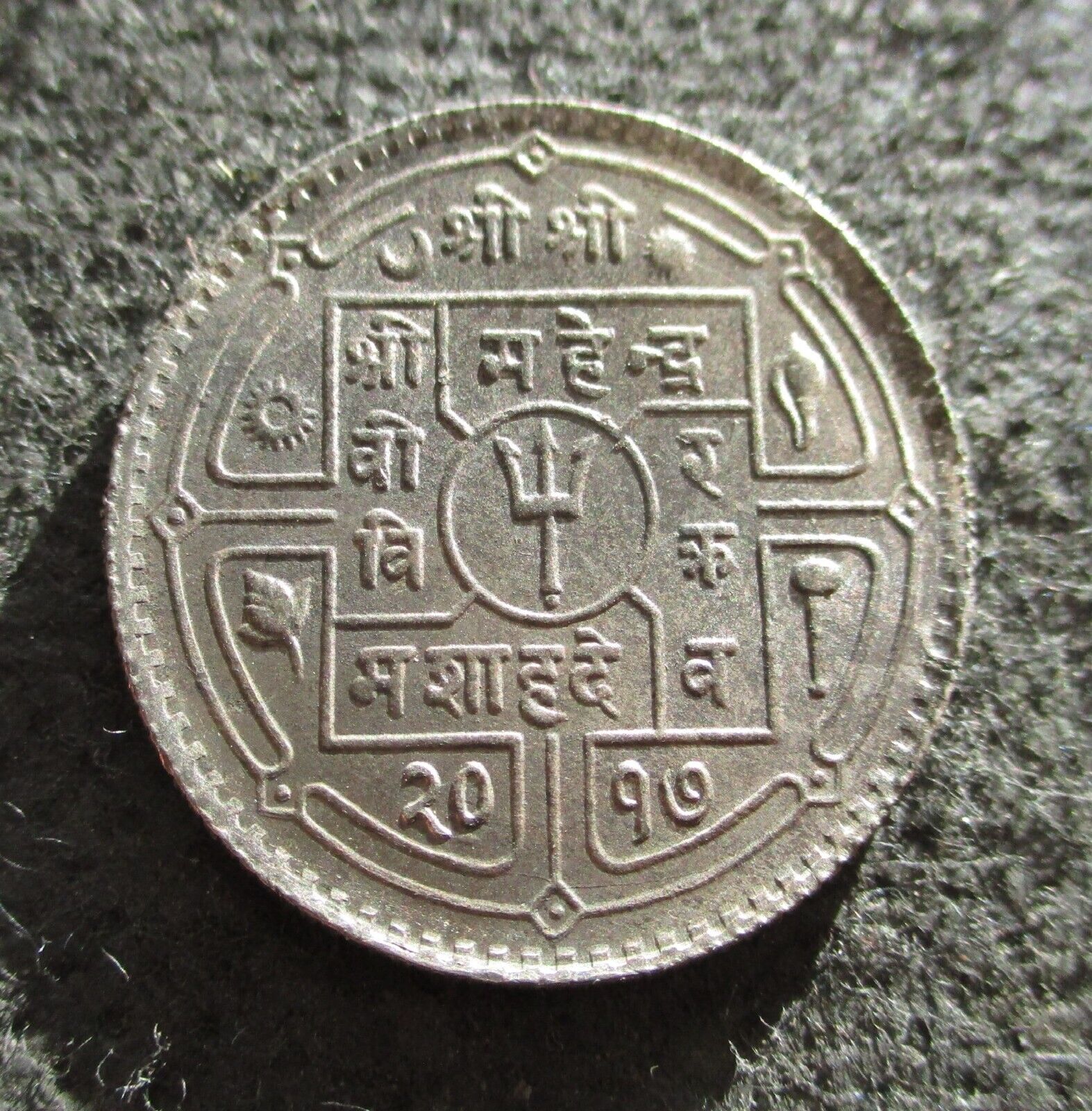-40%
1974 NEPAL King Birendra Bir Bikram Red Panda Proof Silver 50 Rupee Coin i90065
$ 284.4
- Description
- Size Guide
Description
Item:i90065
Authentic Coin of:
Nepal
under Birendra Bir Bikram Shah - King: 31 January 1972 - 1 June 2001
1974 Proof
Silver 50 Rupee 41mm (
31.96
grams) 0.925 Silver (1.0409 oz. ASW)
Referene: KM# 841a
Bust of Mahendra Bir Bikram right.
Red Panda.
You are bidding on the exact item pictured, provided with a Certificate of Authenticity and Lifetime Guarantee of Authenticity.
Birendra Bir Bikram Shah
(29 December 1944 - 1 June 2001) was the King of Nepal from 1972 until 2001. The eldest son of King Mahendra, he reigned until his death in the 2001 Nepalese royal massacre.
Personality
From a very young age, Birendra was described by his school teachers as a very kind and emotional prince. King Birendra was described as one of the few Nepalese monarchs who wanted the Nepalese people to experience real democracy. This was observed in the 2036 B.S.
Janmat Sangraha
(1980 Referendum) when he wanted the people to choose whether they wanted 'Multiparty Democracy' or a 'Reformed Panchayat System'. Also, in People's Movement I, he decided to establish a constitutional monarchy in Nepal instead of fighting for a dictatorship.
In 1989, when the People's Movement I was taking momentum, as a condition of safeguarding the Panchayat system, India put forward some conditions to King Birendra aimed at taking control of national sovereignty. If the King had accepted these conditions, the panchayat system would not have ended. But the king said that, "It is better to surrender to the people rather than surrender to India."
Some historians have speculated that King Birendra's democratic views and simple nature led to the success of the People's Movement I (1990). He is credited for introducing SAARC in Asia in order to strengthen the foreign relations of Nepal with the other South Asian countries.
Early life
King Birendra was born at the Narayanhiti Royal Palace in Kathmandu as the eldest son of the then Crown Prince Mahendra Bir Bikram Shah Dev and his first wife, Crown Princess Indra Rajya Lakshmi Devi.
Birendra spent eight years studying at St Joseph's School, a Jesuit school in Darjeeling, with his brother Gyanendra. On 13 March 1955 their grandfather King Tribhuvan died and their father succeeded to the Nepalese throne. With his father's ascension King Birendra became the Crown Prince of Nepal.
In 1959 King Birendra enrolled at Eton College in the United Kingdom. After studying at Eton until 1964, he returned to Nepal where he began to explore the country by travelling on foot to the remote parts of the country where he lived on whatever was available in the villages and monasteries. He later completed his education by spending some time at the University of Tokyo, before studying political theory at Harvard University from 1967 to 1968. King Birendra enjoyed traveling in his youth and went on trips to Canada, Latin America, Africa, many parts of India and a number of other Asian countries. He was also an art collector and supporter of Nepalese crafts people and artists, and learnt to fly helicopters.
King Birendra was married to Aishwarya Rajya Lakshmi Devi from the Rana family, his second cousin, on 27 February 1970. The wedding, which was billed as one of the most lavish Hindu nuptial ceremonies in history, cost .5 million to stage. King Birendra and Queen Aishwarya had three children:
Prince Dipendra (27 June 1971 - 4 June 2001).
Princess Shruti (15 October 1976 - 1 June 2001).
Prince Nirajan (6 November 1978 - 1 June 2001).
Early reign
Birendra succeeded to the Nepalese throne on 31 January 1972, at the age of 27, after the death of his father King Mahendra. On his ascension he was effectively an absolute monarch, as he inherited a country where political parties were banned and he ruled through a system of local and regional councils known as panchayats. Birendra resented the imputation that he was an absolute monarch, maintaining that he presided over a democracy in which representatives to the assembly were indirectly elected and saying that his poor and backward country could not afford a democracy based on party politics and that it needed firm and decisive government. His first trips abroad as king were to India in October 1973 and China two months later as he believed that Nepal, sandwiched between the two Asian powers, should have good relations with both.
Coronation in 1975
After his father's (King Mahendra) death in 1972, King Birendra consulted his court astrologers, who advised him to delay his coronation for three years, with the most auspicious moment for his crowning being at 8:37 am precisely on February 4, 1975. Soon after dawn on that day, King Birendra was driven to the temple of his ancestral palace, the Hanuman Dhoka ("gate of the monkey god"). There he was smeared with mud taken from various symbolic places - the bottom of a lake, the tusk of an elephant, a mountain, the confluence of two rivers and the doorstep of a prostitute's house. Then, with Queen Aishwarya beside him, he was cleansed with butter, milk, yogurt and honey as priests chanted praises and salutations.
The coronation ceremony was attended by statesmen and political leaders from 60 nations, with the Prince of Wales representing the British Royal Family. The King's personal guests included his former housemaster at Eton, Peter Lawrence, three other masters and 15 old boys. At the ordained time, the chief priest placed on the King's head the emerald green crown, encrusted with jewels and adorned with feathers from a bird of paradise.
On the auspicious occasion of his coronation, the King announced that he had ordered his government to make primary education available and free for every child, but disappointed those Nepalis who hoped that he would promise progress towards democracy.
Zone of Peace Proposition
King Birendra announced of Nepal Zone of Peace proposition during his coronation ceremony reception. He formally asked the international community to endorse his proposal that the United Nations should declare Nepal a ZoP, to give a new dimension to Nepalese stance for non-aligned movement.
1980 referendum
In an attempt to maintain the
panchayat
system of government prominent leaders of the Nepali Congress Party were arrested. Because of the growing pro-democracy movement Birendra announced that a referendum to decide between a non-party and a multi-party system would be held. The referendum was held in May 1980 with the non-party system winning by a margin of 55% to 45%. During the 1980s the restraints that had been imposed on political organisations started to ease, and liberal student-led groups started to demand constitutional change in Nepal.
He was appointed as a British Field Marshal in 1980.
Democratic era
In 1990, a series of strikes and pro-democracy riots broke out in Nepal. Because of the rioting, King Birendra lifted the ban on political parties and agreed to become a constitutional monarch in April, 1990. He appointed an independent Constitution Recommendation Commission to represent the main opposition factions and to prepare a new constitution to accommodate their demands for political reform. The commission presented him with the draft of the proposed constitution on 10 September 1990. The new constitution would make Birendra head of state of a constitutional monarchy with a system of multiparty democracy. The draft constitution was approved by the Prime Minister Krishna Prasad Bhattarai and his cabinet and so, on 9 November 1990, Birendra promulgated the new constitution transforming Nepal into a constitutional monarchy. King Birendra appointed an interim government to pave the way for elections. To head this he chose Krishna Prasad Bhattarai, who he had imprisoned for several years. In a discussion on BBC radio, Krishna Prasad Bhattarai spoke of King Birendra's impeccable personal manners and courtesy and his equally impeccable role as a constitutional monarch.
However, the quarrels between various political parties and numerous social problems led to the Nepalese Civil War, a conflict between Maoist rebels and government forces, which lasted from 1996 until 2006.
Death
The stability of Nepal was threatened even more when Birendra and his family (including Queen Aishwarya) were massacred at a royal dinner on 1 June 2001.
Almost all of the Royal family members were killed in the massacre except Gyanendra Shah, Birendra's younger brother. Dipendra was proclaimed king but died a few days later of self-inflicted gunshot wounds sustained in the massacre. Thus Gyanendra then became king.
Eyewitness reports and an official investigation (carried by a two-man committee made up of the Chief Justice of the Supreme Court Keshav Prasad Upadhaya and the Speaker of the House of Representatives Taranath Ranabhat), confirmed that Dipendra was the gunman. Detailed investigation is impossible as the "Tribhuvan Sadan" (the building where the massacre occurred) was demolished by the Gyanendra government which made Gyanendra the most unpopular king.
Nepal
, officially the
Federal Democratic Republic of Nepal
is a landlocked country in South Asia. It is located mainly in the Himalayas but also includes parts of the Indo-Gangetic Plain. With an estimated population of 26.4 million, it is 48th largest country by population and 93rd largest country by area. It borders China in the north and India in the south, east, and west while Bangladesh is located within only 27 km (17 mi) of its southeastern tip and Bhutan is separated from it by the Indian state of Sikkim. Nepal has a diverse geography, including fertile plains, subalpine forested hills, and eight of the world's ten tallest mountains, including Mount Everest, the highest point on Earth. Kathmandu is the nation's capital and largest city. Nepal is a multiethnic nation with Nepali as the official language.
The name "Nepal" is first recorded in texts from the Vedic Age, the era in which Hinduism was founded, the predominant religion of the country. In the middle of the first millennium BCE, Gautama Buddha, the founder of Buddhism, was born in southern Nepal. Parts of northern Nepal were intertwined with the culture of Tibet. The centrally located Kathmandu Valley was the seat of the prosperous Newar confederacy known as Nepal Mandala. The Himalayan branch of the ancient Silk Road was dominated by the valley's traders. The cosmopolitan region developed distinct traditional art and architecture. By the 18th century, the Gorkha Kingdom achieved the unification of Nepal. The Shah dynasty established the Kingdom of Nepal and later formed an alliance with the British Empire, under its Rana dynasty of premiers. The country was never colonised but served as a buffer state between Imperial China and colonial India. Parliamentary democracy was introduced in 1951, but was twice suspended by Nepalese monarchs, in 1960 and 2005. The Nepalese Civil War in the 1990s and early 2000s resulted in the proclamation of a secular republic in 2008, ending the world's last Hindu monarchy.
The Constitution of Nepal, adopted in 2015, establishes Nepal as a federal secular parliamentary republic divided into seven provinces. Nepal was admitted to the United Nations in 1955, and friendship treaties were signed with India in 1950 and the People's Republic of China in 1960. Nepal hosts the permanent secretariat of the South Asian Association for Regional Cooperation (SAARC), of which it is a founding member. Nepal is also a member of the Non Aligned Movement and the Bay of Bengal Initiative. The military of Nepal is the fifth largest in South Asia; it is notable for its Gurkha history, particularly during the world wars, and has been a significant contributor to United Nations peacekeeping operations.
Frequently Asked Questions
Mr. Ilya Zlobin
, world-renowned expert numismatist, enthusiast, author and dealer in authentic ancient Greek, ancient Roman, ancient Byzantine, world coins & more.
Who am I dealing with?
You are dealing with Ilya Zlobin, ancient coin expert, enthusiast, author and dealer with an online store having a selection of over 15,000 items with great positive feedback from verified buyers and over 10 years experience dealing with over 57,000 ancient and world coins and artifacts. Ilya Zlobin is an independent individual who has a passion for coin collecting, research and understanding the importance of the historical context and significance all coins and objects represent. Most others are only concerned with selling you, Ilya Zlobin is most interested in educating you on the subject, and providing the largest selection, most professional presentation and service for the best long-term value for collectors worldwide creating returning patrons sharing in the passion of ancient and world coin collecting for a lifetime.
How long until my order is shipped?
Orders are shipped by the next business day (after receipt of payment) most of the time.
How will I know when the order was shipped?
After your order has shipped, you will be left positive feedback, and that date could be used as a basis of estimating an arrival date. Any tracking number would be found under your 'Purchase history' tab.
USPS First Class mail takes about 3-5 business days to arrive in the U.S. International shipping times cannot be estimated as they vary from country to country.
Standard international mail to many countries
does not
include a tracking number, and can also be slow sometimes.
For a tracking number and signature confirmation, you may want to do Express Mail International Shipping, which costs more, however, is the fastest and most secure. Additionally you may be able to receive your order in as little as 3-5 business days using this method. For Express Mail International, it may be possible to place up to 10-15 items in one package (for the one shipping cost) as it is flat rate envelope, which may be the most cost-effective, secure and fastest way to receive items internationally. Send me a message about this and I can update your invoice should you want this method.
Getting your order to you, quickly and securely is a top priority and is taken seriously here.
Great care is taken in packaging and mailing every item securely and quickly.
Please be aware, I cannot take responsibility for any postal service delivery delays, especially for international packages as it may happen in rare instances.
What is a certificate of authenticity and what guarantees do you give that the item is authentic?
Each of the items sold here, is provided with a Certificate of Authenticity, and a Lifetime Guarantee of Authenticity, issued by a world-renowned numismatic and antique expert that has identified over 57,000 ancient coins and has provided them with the same guarantee. You will be very happy with what you get with the COA; a professional presentation of the coin, with all of the relevant information and a picture of the coin you saw in the listing. Additionally, the coin is inside it's own protective coin flip (holder), with a 2x2 inch description of the coin matching the individual number on the COA.
On the free-market such a presentation alone, can be considered a - value all in itself, and it comes standard with your purchases from me,
FREE.
With every purchase, you are leveraging my many years of experience to get a more complete context and understanding of the piece of history you are getting. Whether your goal is to collect or give the item as a gift, coins presented like this could be more prized and valued higher than items that were not given such care and attention to.
Buy a coin today and own a piece of history, guaranteed.
Is there a money back guarantee?
I offer a 30 day unconditional money back guarantee. I stand behind my coins and would be willing to exchange your order for either store credit towards other coins, or refund, minus shipping expenses, within 30 days from the receipt of your order. My goal is to have the returning customers for a lifetime, and I am so sure in my coins, their authenticity, numismatic value and beauty, I can offer such a guarantee.
When should I leave feedback?
Once you receive your order, please leave a positive feedback. Please don't leave any negative feedbacks, as it happens sometimes that people rush to leave feedback before letting sufficient time for their order to arrive. Also, if you sent an email, make sure to check for my reply in your messages before claiming that you didn't receive a response. The matter of fact is that any issues can be resolved, as reputation is most important to me. My goal is to provide superior products and quality of service.
How and where do I learn more about collecting ancient coins?
Visit the "
Guide on How to Use My Store
" for on an overview about using my store, with additional information and links to all other parts of my store which may include educational information on topics you are looking for.
